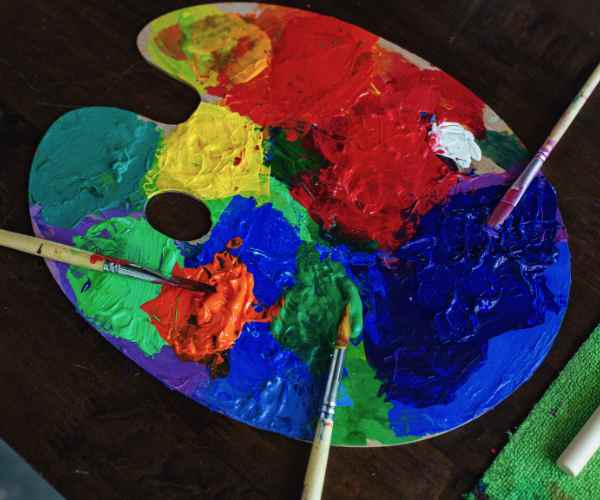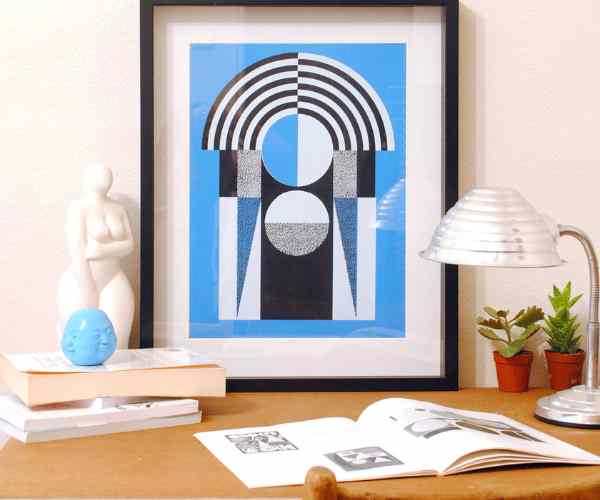Allow me to take you back to an episode in my art journey that made me fully grasp the importance and dominance of color Let me take you back to a moment in my art journey that truly opened my eyes to the power of color. I was sitting in my small studio, staring at a canvas that felt utterly lifeless. I had poured my heart into it, but something was off.
That is when I decided to change my palette from the drab shades I used to a striking combination of blue and orange. Everything changed. I felt a sudden surge of energy after the colors were applied to the canvas and allowed them to travel around.
The scene that had previously been so bland was now a joyous sunset filled with life and zeal. That encounter was eye opening. I understood how important it is to make color decisions both when producing art and at the narrative stage, where emotions must be expressed.
For the artist, color theory goes beyond the realm of technique; it is a means of communication, a form of art that has many emotions attached to it. If artists can learn to appreciate and utilize color theory within their works, their artwork will evolve into something remarkable. It offers fresh perspectives on the relationship between colors and the feelings or emotions they can incite when being viewed Color depicts robust ideas and messages.
To the best of our knowledge, once the basics of color theory settle in hand for the artist, a completely new dimension of creativity opens up. In this paper, we will discuss how color theory can be useful in raising inspiration when creating comprehensive works of art.
I’ll provide concrete evidence and numerous case studies that will help you utilize color in your art in a more powerful way.
Now, let’s take a plunge into this colorful universe together!

What is color theory? –Understanding Color Theory
So what is color theory precisely?
To begin with color theory is a set of ideas that deals with how colors behave with one another in conjunction and alone.
It is like a guide that helps an artist understand the amount of color they can add to their work of art.
Color theory allows artists to strategize by choosing certain shades when designing color palettes so that their imagination materializes in the form they desire.
Over the many years, Color theory has changed drastically.
Color has always been an area of interest among scientists and artists from the newtons developing the first color wheel in the 17th century to ancient Egyptians using colors to express sentiments and beliefs.
During the 19th century, Impressionist movements were made possible by the likes of Monet and Vincent who disregarded tradition and instead focused on the impact colors could have.
This theme has been pursued by a large number of artists, emphasizing that color is more than just decoration; rather, a method of narrating a tale and establishing a bond.
The color wheel and its relevance
Now let us go into detail about one of the primary instruments used in color theory and that is the color wheel.
Color wheel is a circular representation of colors and their interrelationships, which can also be illustrated as a diagram.
There are three basic colors from which everything else is derived: blue, yellow, and red.
If we take two of the primary colors and blend them, we will get the tertiary colors, which are orange, green, and purple.
Furthermore, we have colors that combine a primary and a secondary color, such as red-orange or yellow green.
The color wheel is an important tool because it visualizes colors and their combinations, which makes it easier to relate them with each other.
For instance, colors opposite each other on the wheel are called complementary colors blue and orange and blue, blue green, and green are analogous due to their proximity on the wheel.
Here is a practical example that will help you appreciate the concept of the color wheel.
Take Henri Matisse, the artist admired for his imaginative use for color.
Complementary colors and energy were employed by Matisse in Dance and in Dance he used orange colors for the dancers over blue dresses that created a great feeling of motion and stimulation.
Emotions in the work are always complemented and enhanced by the shocking shifts of color balance any scene might have.
When we begin to understand the color wheel and how ideas are able to use it, paintings that seem dull slowly turn into master pieces.
Understanding the Psychology of Color
How Color Influences Emotions
Colors do not only serve an aesthetic purpose, but they also have the ability to create emotions and determine an atmosphere.
Remember when you looked at a creative piece and experienced an overwhelming surge of emotion?
Well, it is highly probable that the painter played with colors in order to help evoke that feeling.
For instance, warm colors such as red, orange and yellow can indicate warmth, energy and passion.
Cooler colors, on the other hand, such as blue and green create calm and tranquil feelings.
Take for example Mark Rothko’s imagery.
A combination of deep reds, oranges, blacks and even purple are used to create a field which evokes deep emotions and a sense of deep planes as one looks at the art.
When you stare at one of his pieces of canvas, you can almost feel the colors are trying to say something to you without using any words.
How to Pick the Best Colors for Your Iintended Audience
So how do you find the most appropriate colors that suit the message your painting is conveying?
In this case, you should first think about what feelings you want to create.
Is it happiness, sadness, peace, chaos, etc.?
Once that is done, then color theory becomes useful.
For instance, to communicate calmness, you might want to go for light blues or greens that would most likely have a connection to nature. Alternatively, if your goal is to grab attention, you would then be better served by using vivid red and yellow colors. Now in order to give you some historical context, let’s discuss how renowned painters were able to use color to express emotions. Picasso was able to use varying shades of blue during his Blue Period to demonstrate how art should evoke emotion. In this instance, anime artists can draw the expression and depict it through emotion followed by adding music which further enhances the viewing experience. What you need to note however is the fact that color plays a crucial role in art. So when people in the contemporary world tell you that they hate the color pink while expressing outraged at the color blue, don’t listen to them. There’s a reason why. Each of these shades evokes many memories that alter the state of mind. For example, blue is an all time favorite of many people since it has always been scientifically proven to calm them down. ujar dan Propagation Artists will go head to head at the Informations War today. However all colors demand respect for their own importance. The more respect an artist has for colors the stronger message he or she is able to convey to the audience. Being aware of color theory in and out greatly assists an artist in their work. We can specifically adjust to enhance certain messages enabling a deeper understanding for our viewers that most might have not comprehended. Applying and modifying these schemas allows for the creation of striking and arresting artworks or crafts. Simba re-evaluates Kiara’s relationship with Kovu and in the process raises the issue of love and relationships. Those artworks that have color schemes are South Park artists make sure apply them to have a strong effect on the use of color and interaction with the audience. More often than not when it comes to engaging with an audience, having disciples warrants color to be the centerpiece of the work.
Envision creating a peaceful landscape, using a greater range of color by seamlessly transitioning from the deep navy of the sky to the cerulean of the water.
This makes things more organized, and gives the audience focus to the setting more easily.
To make a monochromatic scheme look good, pick only one color, and then start using its tints and shades.
You can also consider using white or black to tint lightness or darkness respectively.
It may be helpful for you to make a swatch board showing how different variations of the chosen color look together before you start painting.
Let us now move on to schemes that are classified as analogous, which use colors that are located next to each other on the color wheel.
For example, a combination of blue, blue-green and green can enhance a graphic composition while reflecting the image of a light forest with a lot of warm sunlight.
These colors work well together, which makes them suitable for enabling softer transitions and slight movements in your piece of art.
Usually, when syncretic schemes are used, keep three to five colors that are side by side in color alongside one as a main color.
This keeps the visuals complex without overwhelming the eyes.
Last but not the least, we have complementary color schemes which are the ones where two colors are used that are across from each other on a color wheel.
Envision a scorching red against greenery and notice the distinction— it is astounding.
This strategy works magic for making pinpoints on your artwork.
However, with complementary colors for instance, if you wanted visual excitement or tension, you might use the colors side by side to get those effects.
So for example, if you’re painting a person and the color of their shirt is say red, then you can paint a colored background so that the person stands out from the canvas.
Building up I suppose the difference or depth with the colors.
But color has an effect in mood, and it can also add some depth and difference into your work.
Where you aim the viewer’s sight is predominantly aided by color manipulation and accenting parts in the composition is managed too.
For instance, you can use warmer colors at the front of a landscape you’re painting and move cooler colors to the back.
Peoples’ eyes would view the lighter colors much closer than the cooler shades thereby making it appear three dimensional.
The works of Claude Monet has a very good example of this technique.
Monet’s use of color in his work Water Lilies is nothing short of genius, as he seamlessly blends blue and green tones to achieve the right depth of water while ensuring that the lilies steal the show. Using a painting monochromatically, he constructs a tranquil yet motion-filled picture with himself at the center of it. Look out for the balance between contrast and depth exploring the colors multi-dimensionality. Adding both light and dark stroke is a great way to achieve more mass, and using contrast tones is great for engagement. Go wild with your imagination, try playing with layering colors and notice how they shift and whether or not they complement each other. Color Theory Practical Exercises Let’s Not Assemble a Color Palette This is where it’s time to get our hands dirty! There is an easier route meanwhile, rather than acting in haste aimlessly attempting to mix and match colors to fill in themes, first refine your imagination and then select palettes as per the thoughts in your head. Think of a word, or a feeling and let yourself loose to painting all the ideas you possess. Identify color combinations best suited for the emotion you wish to express — monochromatic, analogous or prime swatches. If you look out for palettes drawn from the inspiration of a forest, brown and green alongside other colors help bring out nature best when combined. Shift around the tint and different shades until you make your ideal combination.
When you have completed your swatches, take them and create smaller sketches or paintings.
Moreover, sharing your creation with others in your drawing class or any social media may bring you some joy.
It is a good idea to have these conversations with others especially if they are color mixing experiments and look for feedback from them to get some fresh ideas.
How To Mix Colors
So now, let’s go over some crucial elements of painting color mixing techniques.
At first it seems mixing colors could be a bit challenging but painting is definitely one of the fun parts of it.
When I first tried to mix a skin color I vividly recall how disappointed I was at the end.
I recall scrambling to come up with at least a single color to make a reference picture as I still didn’t have any good ones.
Though this one was a tad irritating, it did teach me one valuable lesson regarding the balance question: color mixing has a lot to do with balance.
A general rule is to begin with one color and add very little of the second until the desired hue is obtained.
For instance, to obtain a pretty peach, blend together red and yellow and white then take just a hint of white and brighten it.
Always remember—when in doubt stick to using less—such small quantities can have a great impact.
No color tastes horrible, so mix however you like! You may come up with colors that are out of the world.
To sum it up, my recommendation is to start a colour mixing diary.
Note the mixtures that you used, the amounts of each that they used, and the final outcome.
This method can be extremely useful as you look for that specific palette that is accurate to you.
FAQs
What guide should I follow to select a colour scheme for my artwork?
This probably sounds hard at first, but selecting a colour scheme isn’t that much of a challenge once we break it down into steps.
Here is a simple guide that I often share with other artists:
Choose a theme or emotion: Begin by deciding the emotions that you want your artwork to invoke. For example, do you want it to be calm and soothing or lively and full of energy?
Use the Color Wheel: The color wheel is immensely helpful here. Consider whether you wish to use a monochromatic color scheme (one hue), an analogous strategy (adjacent colors), or a complementary color scheme (hues opposite each other).
Make A Color Palette: A few colors that fit your theme. For example, warm colors in orange and pink would be appropriate for a sunset painting.
Add Some White or Black: Do not hesitate to mix in some white and black along with the colors you have chosen. Adding white will create softer tints while the black will make a stronger shade. This way you can add new dimensions to your color scheme.
Make a Test First: Use scrap paper to test colors instead of drawing straight onto your final piece. It is important to see how the colors blend and change over time so that you can make adjustments accordingly.
Go with Your Gut: The most important thing in this process is to simply be intuitive. If a color speaks to you, pick it up! There are no rules in art and your instincts can be very helpful.
What are the most popular color combinations?
The most effective color palettes will always be few regardless of current color trends or your taste, so some combinations will always be prevalent.
Blue and Orange: This pair will never go unnoticed. The warmth of the orange and coolness of blue makes a striking contrasting combination that looks both striking and balanced at the same time.
Red and Green: This combination is not only a classic but has a great recollection factor. Often times used during the festive seasons, red and green used the right way can be very touchy. It is all about the shades; combining a brighter red with a dull green can change the game.
Yellow and Purple: This contrast has an experiential quality that balances out. While Yellow brings a youthful exuberance, Purple is a beautiful modern sophistication.
Monochromatic or Simple Colors: Emphasizing only a single color and making sure to incorporate its tints and shades into an artwork is a very powerful technique. It is the most sought-after technique for artists who want to create richness and elegance without straining the viewer too much.
These combinations work effectively because they strike a balance. They serve as a contrast which invites the viewers gaze and stirs an emotion, thus ensuring that your artwork is meaningful on a deeper level.
Do I have the potential to fight this color introversion?
There is a general unease when it comes to color and most artists have that fear. I recall for example during my initial periods of using bold colors, my paintings always would look a bit dirty, and so were far from how I wanted them to look. So what are the best actionable steps one can take to start using color:
Take it Slow: Incorporate small doses of color into your carefully crafted pieces. A firmly structured figure can have a bright accessory and a single flower in the middle of a whole garden can be painted over. Through doing this, one can have fun with color without feeling like there is too much pressure.
Explore Colors in a Journal: A single journal for colors can enhance one’s creativity. Combine multiple colors, make notes on how their use makes one feel, then see how it improves the range in your work. Eventually, this will help one develop targeting and depth with their color palette.
Use Reference Images: If you own a particular artwork that you have an affinity for, make it a point to examine it closely to help you with your color selection. Make a note of what works for you and what emotions those colors could stimulate. Let this motivate you to paint those kinds of works yourself.
Join a community: It can do wonders for your emotional wellbeing to open various aspects of your life to other artists and let them in, good and bad. You can look for art groups, online forums or groups on social media where you can post your art and get helpful feedback.
Remind yourself it’s okay to make mistakes: After all, every one of them had to go through countless failures. A lesson is learnt from each mistake made, and more often than not, the most unanticipated mixture can result in exquisite outcomes.
Conclusion.
Through this research on color theory, we have been able to embrace the fact that color is a great form of art.
By grasping how to look into various schemes of colors or even understanding the logic behind emotions and depth property that colors possess, these principles are simply tools that can be used in order to advance in your artistic journey.
Let not a fear for making mistakes when it comes to combining colors lead you into withdrawing yourself from trying out new techniques.
Make use of palettes that are not familiar to you, and set for yourself targets for combination so that you’d let your instincts to navigate you through.
Art is a type of self expression, and color is one of the best mediums through which one can express in.
I look for you in the comments section as you share your color combination experiences and your best ones.
Which colors move you to create? How have these colors affected and changed your art processes and creations?
Let me remind you to cherish the beauty of color.





